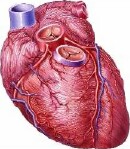
TUESDAY, Dec. 8 (HealthDay News) — The human heart twists and turns as it beats, and a German study shows how the twisting and turning differs between men and women, and young and old.
In the study, published in the Dec. 8 online edition of Circulation: Cardiovascular Imaging, researchers at University Hospital Freiburg describe the different heartbeats they saw in 29 men and 29 women, all healthy, using an advanced imaging technology called MRI tissue phase mapping. The participants ranged in age from 20 to 60-plus.
The healthy heart doesn’t just contract as it pumps blood. The base of the left ventricle, the chamber that pumps blood to the body, changes its direction of rotation up to six times for each beat.
“The left ventricle doesn’t just shorten or get narrower,” said Dr. Thomas C. Gerber, professor of medicine and radiology at the Mayo Clinic in Jacksonville, Fla. “It really twists like a dishrag, a very effective way of getting the blood out.”
Clear differences by age and gender emerged from the study, the report said. Among them:
- The rotation speed of the apex of the heart decreases with age.
- Younger women have higher up-and-down motion velocities along the long axis of the ventricle than younger men, but those differences were reversed in older men and women.
- Compared to men, women demonstrated reduced twisting of the ventricle, apex rotation and muscle velocity toward the center of the left ventricle during contraction.
The study could lead to the use of such coronary imaging in diagnosing heart problems, cardiologists say.
“To understand what is abnormal, we have to understand what is normal, and that can differ by gender and age,” said Gerber. Full knowledge of those normal differences could help physicians understand “which abnormalities correspond to a particular disease phase,” he said.
“This information could change the diagnosis and assessment of heart disease from its earliest stages,” the lead author of the report, Dr. Daniela Foell, a senior consultant in cardiology at the University Hospital Freiburg, said in a news release.
But there’s a long way to go before that happens, Gerber noted.
“At this stage of the game, it is a nice proof of principle paper, but to make it clinically useful, other groups would have to use the same tools to see if they get the same results and in a much larger group of patients,” he said.
Also, the study included only a selected group of Germans, Gerber pointed out. “This was a fairly small group and to accept this as normal findings across the world would be premature,” he said.
While the study “hasn’t uncovered anything breathtakingly new,” it has provided very detailed information about the normal heartbeat and sets the stage for more detailed future studies, Gerber added.
“If we had a large data base for different ages and genders, we could establish what is normal and then we could tell for a particular patient whether a particular aspect of cardiac rotation was abnormal, and that would tell the physician that something was wrong,” Gerber said. “But there are no abnormalities we know now that are specific for a particular disease.”
More information
Learn how cardiologists use MRI from the U.S. National Library of Medicine.

